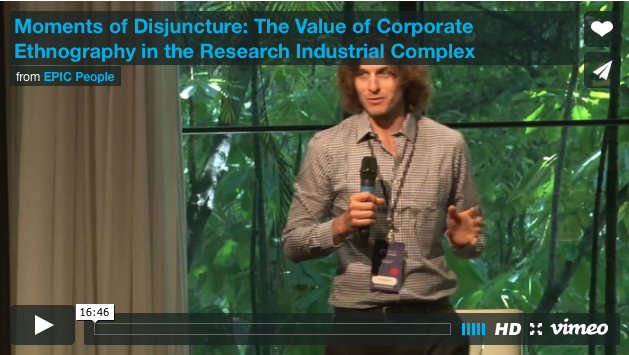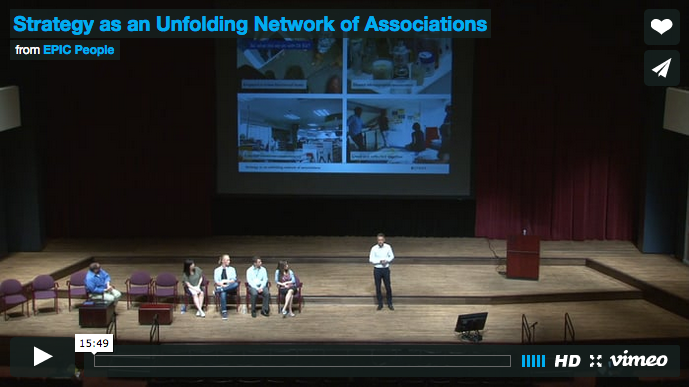Strategy
This collection highlights the value of ethnography for strategy and decision making, including frameworks and methods for embedding ethnographic practice deeper into an organization's strategic practices.Overview
In its grounding in everyday experience, ethnography often delights in nuance, particulars, and the irreducibility of social complexity. Yet ethnographers can also impact the strategic direction of their organizations or clients. How does bottom-up insight translate into top-level strategic direction?
This question is more pressing than ever as companies build large research arms and produce extensive research on every product, user experience, customer segment, and more, often without consistent coordination or consolidation of findings. This can lead to forgotten – or worse, discarded – research. How can ethnography both position itself to influence strategy from the outset and ensure insights ladder up into a shared strategic direction?
Members of the EPIC community have explored these quandaries for many years, reflecting on the role of the ethnographer in relation to organizational strategy, and how their insights can be best positioned to impact strategic decisions. The selection of papers below highlights methodologies, framings, and processes that can elevate and embed ethnographic practice deeper into organizations’ strategic practices.
Key Articles
Building an Innovation Strategy from Cultural Insights, Jay Hasbrouk (2018). Hasbrouck tackles a case of a company facing the common problem of lots of accumulated research but little direction to find in it. He details a comprehensive and multi-layered approach through a longitudinal lens, to produce a broad set of meta-insights that inform strategic direction for an innovation team. A subsequent set of analyses of the company’s internal culture, stakeholder cultures, and “analogous cultures” helped inform the translation of these insights into cultural relevance for the company. The result of this was a “compass” that helped consolidate their work into an innovation strategy that could position and prioritize projects for the innovation team. Read this for inspiration on how to sift through and synthesize a large volume of previous research systematically.
Moments of Disjuncture: the Value of Corporate Ethnography in the Research Industrial Complex, Shaheen Amirebrahimi (2012). This paper reflects on the peculiar ‘moments of disjuncture’ in major technology companies (Amirebrahimi speaks from experience with Intel), where research-derived insights are often dismissed as “been done before.” He traces this reception to the larger systemic issues that plague the translation of insights into a company logic. In this translation, complex, nuanced findings are severed from context to become commodities whose newfound generality risks repetition. To remedy this, Amirebrahimi suggests close engagement with stakeholders and having anthropologists “go native” and become business decision-makers themselves. Explore Amirebrahimi’s work for a rich, theoretical framing of ethnography and ‘the insight’ in a commercial context.
Tracing the Arc of Ethnographic Impact: Success and (In)visibility of Our Work and Identities, Donna K. Flynn and Tracey Lovejoy (2014). This paper explores the trials of ethnographic research in delivering impact on large product organizations, based on their own experiences at Microsoft. Drawing on their own trajectories from narrower usability testing to more strategic and direction-setting work, the authors argue that for ethnographic research to be impactful, it must position itself early in the product life cycle, target the right stakeholders, and deliver data relevant to the present concerns of the product team. If not, ethnographic research risks being cast by the wayside. Read this for detailed insight into the trajectory of ethnography in big technology companies and inspiration for how to best position ethnography for impact.
Heroic Complexity in Strategic Innovation, Tony Salvador (2010). Salvador illuminates the problem of strategic innovation by framing it as a violence to a complex homeostatic system that seeks persistence of its form. Innovation thus is framed as a mythical hero’s journey, which must go into the wilderness, face trials, and take its hard-won insights back into the fold of the company. To get a “hero’s welcome,” the strategic innovator must pay attention to this system – its processes and equilibrium – to understand how their strategic innovation disrupts and how best they can redirect system energy. Explore this paper for a surprising take on how to create the right conditions in a company for impact with ethnographic insights.
Guides Not Gurus, Catherine Howard and Peter Mortensen (2014). This paper targets the biggest challenge to anthropological research’s success – the hand off to the client. Drawing on considerable experience in the industry, the authors describe five principles to make sure ethnographic research has a higher impact. Ethnographers are recommended, for example, to invite clients into the field, show clients interesting customers as well as the most common, and choose the right medium for their message. Rather than adopting the role of customer experience guru, ethnographers should be “guides who take everyone in the company into the outside world.” Read this for inspiration on how to involve stakeholders deeper in your research.
Go Deeper
Strategy as an Unfolding Network of Associations, Tom Hoy and Tom Rowley (2015). This work makes a case for a more complex and living notion of strategy as a network. The authors detail a business strategy development process performed with a healthcare company, including intense ethnographic research and a one-year follow-up with management interviews to assess their contribution to informing the organization’s strategy. On the basis of this work they argue for a core shift in the concept of strategy—from a “static set of choices” at a certain point in time, to “an unfolding network of associations” of people, their shared experiences, and artifacts.
Taking the Driver’s Seat: Sustaining Critical Enquiry While Becoming a Legitimate Corporate Decision-Maker, Rogerio De Paula, Suzanne L. Thomas and Xueming Lan (2014). Researchers at Intel give an account about how the role of ethnographers there has developed over the past decades to include a significant portion of product strategy. Initially treated as exotic social researchers with barely legitimate methods, their insights were rarely well integrated into corporate strategy. Over time, however, their roles adopted more business responsibilities as they sought to translate their findings for better impact in the corporate context. These shifts raise questions for how ethnography can ensure impact, but also how it can maintain integrity while doing so.
Five Steps Behind: How Ethnography Based Strategy Can Fuel Ingredient Innovation in the Early Stages of the Value Chain, Martin N. Millard and Yosha Gargeya (2007). Strategists at ReD Associates detail how ethnographic research can be used to help shape the strategy of a FMCG supplier to enable more proactive innovation in an industry where it is traditionally shaped from without. In modern FMCG value chains, innovation directives from the customer-facing brand often strangle the innovation flexibility of suppliers and result in piecemeal, conventional and inefficient innovation by suppliers. An ethnographic study by ReD Associates provided a novel insight on customers that helped facilitate strategic discussions with the customer-facing brands and thereby made more meaningful innovation possible.


Curators: Esben Ronan & Ian Dull
Contributor: Elizabeth Anderson-Kempe








